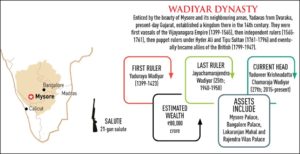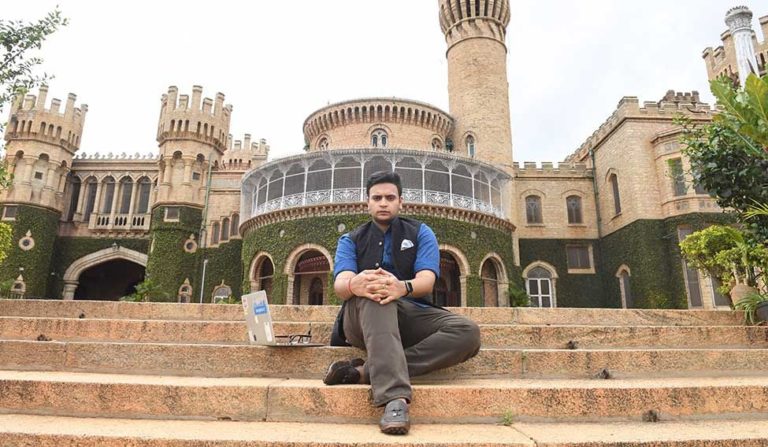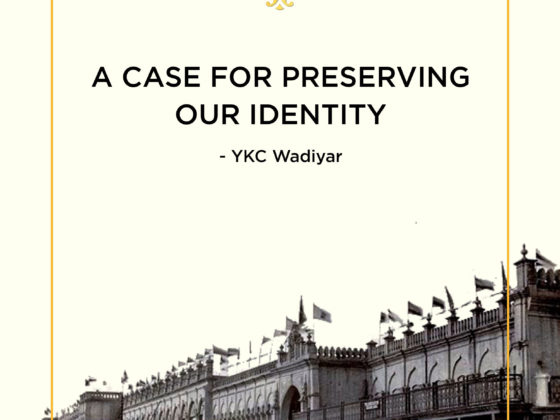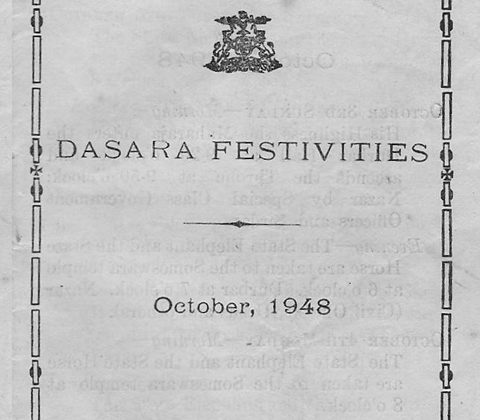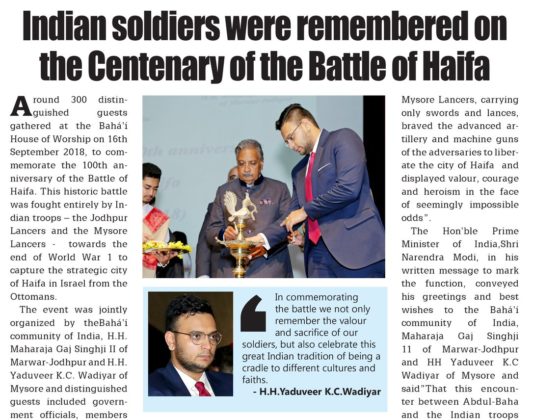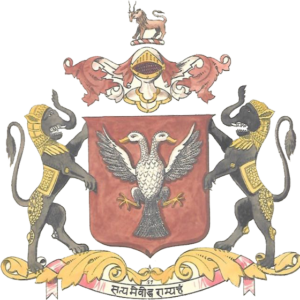The Wadiyars had one of the longest reigns in India and the royal family, led by a 25-year-old, still plays a big role in society
When Mysuru celebrates Dasara, the world watches in awe. The erstwhile princely state has a long tradition—more than 400 years—of celebrating the festival with grandeur. The Mysore Palace hosts a durbar attended by the royal family, special invitees and the masses. The festivities include a ceremonial military parade, colourful rituals at temples, performance by the palace band and a procession with the idol of Goddess Chamundeshwari atop a royal elephant. The palace, lit up with about one lakh light bulbs, is a sight to behold. The celebration is a reminder that opulence and regality are not relegated to the pages of history. In Mysuru, they are still experienced as a shared and continued legacy of the royals and the commoners.
The 25-year-old, foreign-educated titular maharaja of Mysore, Yaduveer Krishnadatta Chamaraja Wadiyar, is set to conduct the Royal Dasara for the second time. “It is here the old meets the new, tradition blends with modernity,” says Yaduveer. “Dasara might be the window to the past for many. But for me, like most old Mysoreans, it is a continuation of a tradition.”
When Mysuru celebrates Dasara, the world watches in awe. The erstwhile princely state has a long tradition—more than 400 years—of celebrating the festival with grandeur. The Mysore Palace hosts a durbar attended by the royal family, special invitees and the masses. The festivities include a ceremonial military parade, colourful rituals at temples, performance by the palace band and a procession with the idol of Goddess Chamundeshwari atop a royal elephant. The palace, lit up with about one lakh light bulbs, is a sight to behold. The celebration is a reminder that opulence and regality are not relegated to the pages of history. In Mysuru, they are still experienced as a shared and continued legacy of the royals and the commoners.
The 25-year-old, foreign-educated titular maharaja of Mysore, Yaduveer Krishnadatta Chamaraja Wadiyar, is set to conduct the Royal Dasara for the second time. “It is here the old meets the new, tradition blends with modernity,” says Yaduveer. “Dasara might be the window to the past for many. But for me, like most old Mysoreans, it is a continuation of a tradition.”
The Wadiyar dynasty had one of the longest reigns in India. They ruled the kingdom of Mysore from 1399 to 1947 (including reigns as vassals) and are hailed as the architects of a model state. Maharaja Chamaraja Wadiyar X (1863-1894) instituted the Mysore Representative Assembly in 1881. This was the first democratic institution in the country. His successor, Maharaja Krishnaraja Wadiyar IV (1884-1940) rang in Mysore’s golden era. Mahatma Gandhi gave him the title Rajarishi (saintly king) and called the state Ram Rajya (ideal state). He was also one of the wealthiest kings in India. The last king of the Wadiyar dynasty—Maharaja Jayachamarajendra Wadiyar (1919-1974) ruled from 1940 until Indian independence in 1947 when he acceded his kingdom to the dominion of India. He continued as the maharaja until India became a republic in 1950.
The abolition of the privy purse in 1969 saw the royal family of Mysore suffer great financial stress owing to mounting arrears of wealth and income tax. Palace workers were retrenched and the upkeep of the estates became difficult. Subsequently, the royal family found itself mired in litigation to protect its estates.
Jayachamarajendra Wadiyar had transferred land around the Bangalore Palace to two private companies he floated to develop the palace into a luxury hotel. After his death, a civil suit had to be filed to retrieve the land. But in 1996, the Karnataka government passed a legislation to acquire the palace. The royal family went to court and eventually the Supreme Court stayed the acquisition and ordered status quo be maintained.
The state government took over a portion of the Mysore Palace for maintenance in 1976. In 1988, the family approached the High Court to claim it back, as the government which now earned lakhs through tourism at the palace refused to share revenue or settle the arrears. In 1997, the court ruled that the management of the palace be handed over to the royal family. However, the state passed the Mysore Palace Acquisition Act, 1998.
The friction with the government has been a bane for the royal family for a long time. But there is another curse—one where the lines between history and legend blur—that has plagued the Wadiyar family for much longer. This is the curse of Alamelamma. For almost 400 years, every alternate generation of the royal family has gone childless and is forced to adopt an heir.
Legend has it that after Raja Wadiyar I (1552-1617) captured a weakened Srirangapatna, Alamelamma, wife of the deposed ruler Tirumalaraja, uttered a curse which ended, “ …let the Mysore king not beget children”. A repentant king installed a statue of Alamelamma in the Mysore Palace and the royal couple continues to worship it to this day.
“The curse came into prominence when the Doctrine of Lapse came into effect, as it allowed only a biological heir to succeed,” says Yaduveer. “So, the curse gave you an excuse not to follow the doctrine. But it is also true alternate generations have not had children. So there is an irrational aspect, too, which I really cannot explain.” Yaduveer was adopted by Maharani Pramoda Devi in February 2015, more than a year after her husband and Maharaja Srikantadatta Narasimharaja Wadiyar died without naming a successor. His coronation took place on May 28, 2015.
The current titular head was born as Yaduveer Gopalraj Urs, to Swarup Anand Gopalaraj Urs and princess Tripurasundari Devi (daughter of princess Gayatri Devi). He married Trishika Kumari, daughter of Harshvardhan Singh and Maheshree Kumari of the Dungarpur royal family (Rajasthan) on June 27, 2016. The couple is expecting its first child.
Yaduveer went to the Vidya Niketan School and the Canadian International School, both in Bengaluru, before graduating from the University of Massachusetts, majoring in Economics and English.
“My [adoptee] father passed away when I was to begin my last semester in the US,” says Yaduveer. “Later, I was chosen to succeed him, which came as a surprise. I was looking at a career in sustainable energy and development, when the maharani told my mother about her plan to adopt me. Then, suddenly, I realised I was playing a small part in the larger narrative of the centuries-old Wadiyar dynasty.”
Recalling the sudden transition, Yaduveer says: “I studied for five years in the US. But the new role demanded a different form of education.” The transition was, however, smooth for his wife Trishika, he says: “My wife easily adopted to this [life], perhaps due to [her royal] family background.” Trishika studied in Baldwin’s college in Bengaluru and graduated from Boston University.
Being a royal also meant charting a unique journey, to represent a composite culture built over the centuries. “It was an awareness about our culture, which I thought I knew, but I did not,” says Yaduveer. “We are the spiritual and cultural successors to the Vijayanagara empire, which in turn was influenced by many other dynasties—Cholas, Pallavas, Chalukyas, Rashtrakootas. So, I tried to put our tradition and legacy in perspective.” He says that he is living and expressing an ancient message, ideal and symbolism, adding to it and passing it on to the next generation. “The idea that I am a small part of a larger narrative took me some time to comprehend.”
Yaduveer says the goodwill created by his ancestors motivates him to associate with the right causes, and explore ways to contribute.
“It is a democratic country and we have to stay relevant, carve our own path to work for the causes we believe in,” he says. “I am invited to perform special pujas as people believe it can end droughts. I oblige them, but I know we need to do much more than that, as droughts are a reflection of our lack of planning and commitment to conservation.”
His predecessor Srikantadatta Wadiyar, a two-time MP from Mysore, was a connoisseur of music, an ardent cricketer, fashion designer and promoter of Mysore silk (under the Royal Silks brand). Yaduveer is grooved into music. He wakes up to Indian classical music and also enjoys playing the guitar and his newfound love—the veena. He is also a passionate environmentalist.
“Axing of hundreds of trees for a steel flyover, the failing monsoon and dams going dry warn of an alarming future,” he says. “Global warming is a reality. Inspired by my younger sister, I grow organic vegetables. I noticed the Bangalore Palace had so much land and felt it was sinful not to grow plants.” He has taken to a my-garden-to-my-table approach.
Stressing on the need for sustainable development he says: “The maharajas illuminated the Mysore Palace as there was excess power. Today, we face power crisis. It is time to innovate and adopt greener technology. A fine example is the Chinnaswamy Stadium, which has tapped solar energy and is self-sustainable.” Yaduveer actively takes part in afforestation drives and seedball projects (where seeds with nutritive coating are dispersed across vacant lands for germination during monsoon).
His penchant for education drives him to the local government schools to volunteer as a teacher. The maharaja is engaged with Mysuru-based NGO Kalisu Foundation, which runs the Maharajarinda Kaliyiri (learn from the king) programme across 14 government schools.
“I was appalled at the state of elementary schools,” says Yaduveer. “It is not to do with funds, but the focus and motivation. Unless we catch the children’s attention, we cannot motivate them to learn. I am doing my bit by trying to inculcate students’ interest in learning. I conduct quiz on general knowledge, hygiene and conservation.”
He is also a fan of the Swachh Bharat initiative. “It is good to see policy and campaign built around Swachh Bharat,” he says. “But it is no time for complacency. The awareness about hazards of plastic and safe disposal of garbage should percolate to the classrooms. Political will is crucial to resolve many issues.”
Staying contemporary and relevant being the key, will he enter politics like his predecessor? He does not rule out the possibility. “I follow politics, though I avoid being opinionated in public,” he says. “Right now, I am focusing on things that demand my attention. My mother is handling the tougher part like litigations. I would like to lessen her burden.”
Like most royals now, this king has a palace but no kingdom. The royal family’s revenues come mainly from venues rented out for commercial activities. But Yaduveer says: “I am not the owner, only a custodian of this legacy, the royal estates and the goodwill of people.
